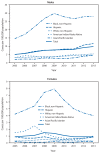Primary and secondary syphilis--United States, 2005-2013
- PMID: 24807239
- PMCID: PMC5779405
Primary and secondary syphilis--United States, 2005-2013
Abstract
In 2013, based on data reported as of April 28, 2014, the rate of reported primary and secondary syphilis in the United States was 5.3 cases per 100,000 population, more than double the lowest-ever rate of 2.1 in 2000. To characterize the recent epidemiology of syphilis in the United States, CDC analyzed data from the National Notifiable Diseases Surveillance System (NNDSS) for cases of primary and secondary syphilis diagnosed during 2005-2013 with a focus on states that reported the sex of sex partners during 2009-2012 to describe reported syphilis among gay, bisexual, and other men who have sex with men (collectively referred to as MSM). During 2005-2013, primary and secondary syphilis rates increased among men of all ages and races/ethnicities across all regions of the United States. Recent years have shown an accelerated increase in the number of cases, with the largest increases occurring among MSM. Among women, rates increased during 2005-2008 and decreased during 2009-2013, with different trends among different racial/ethnic groups. Racial/ethnic disparities in reported syphilis persisted during 2005-2013, likely reflecting social determinants of health, such as socioeconomic status, that might contribute to the burden of syphilis in a community. These findings underscore the need for continued syphilis prevention measures among MSM.
Figures


References
-
- CDC. Sexually transmitted disease surveillance 2012. Atlanta, GA: US Department of Health and Human Services, CDC; 2014. Available at http://www.cdc.gov/std/stats12/default.htm.
-
- Kerani RP, Fleming M, Golden MR. Acceptability and intention to seek medical care after hypothetical receipt of patient-delivered partner therapy or electronic partner notification postcards among men who have sex with men: the partner’s perspective. Sex Transm Dis. 2013;40:179–85. - PubMed
-
- CDC. Sexually transmitted diseases treatment guidelines, 2010. MMWR. 2010;59(RR-12) - PubMed
-
- Bernstein K, Liu KL, Begier E, Koblin B, Karpati A, Murrill C. Same-sex attraction disclosure to health care providers among New York City men who have sex with men: implications for HIV testing approaches. Arch Intern Med. 2008;168:1458–64. - PubMed
MeSH terms
Supplementary concepts
LinkOut - more resources
Full Text Sources
Medical
Miscellaneous

